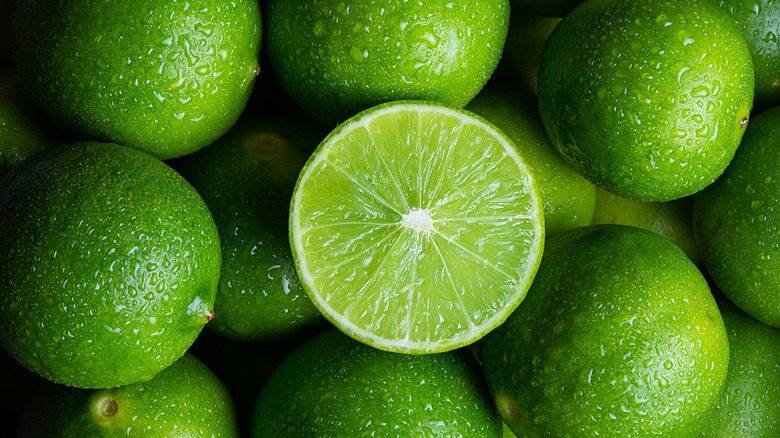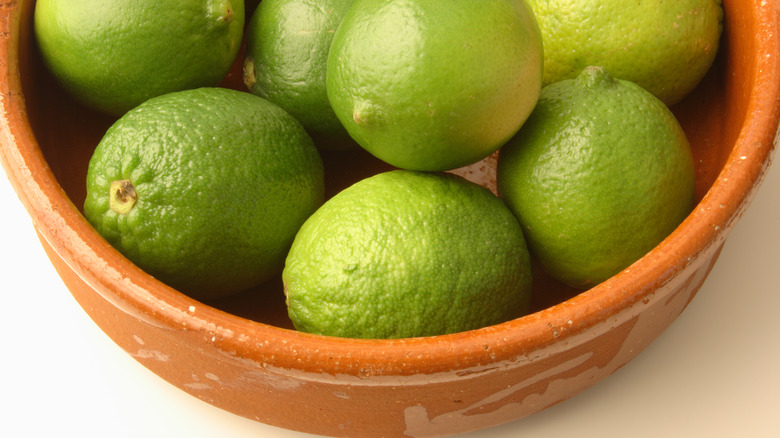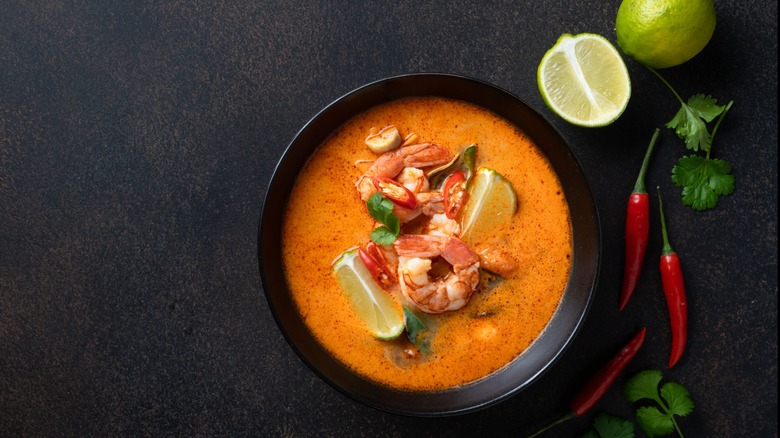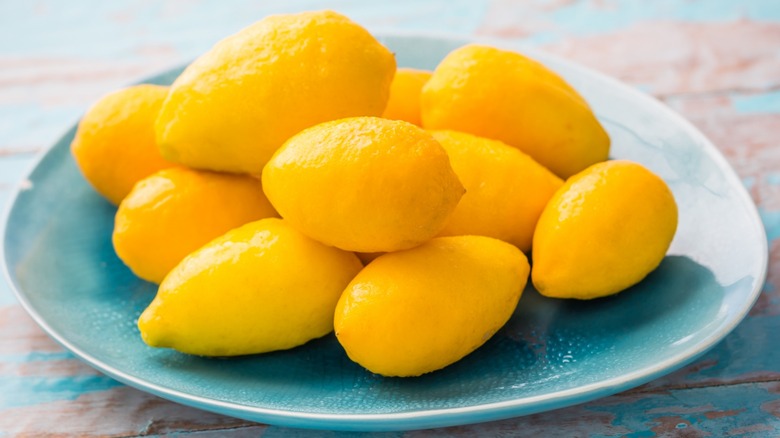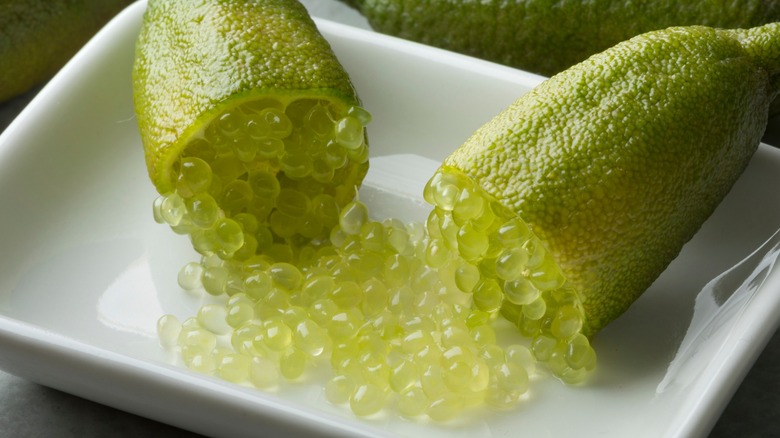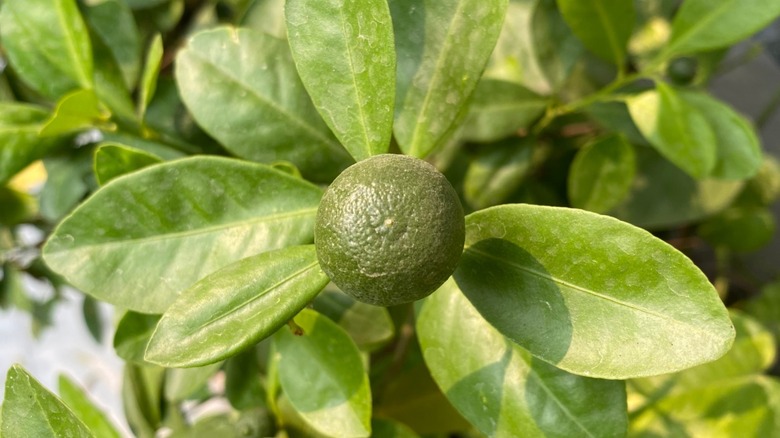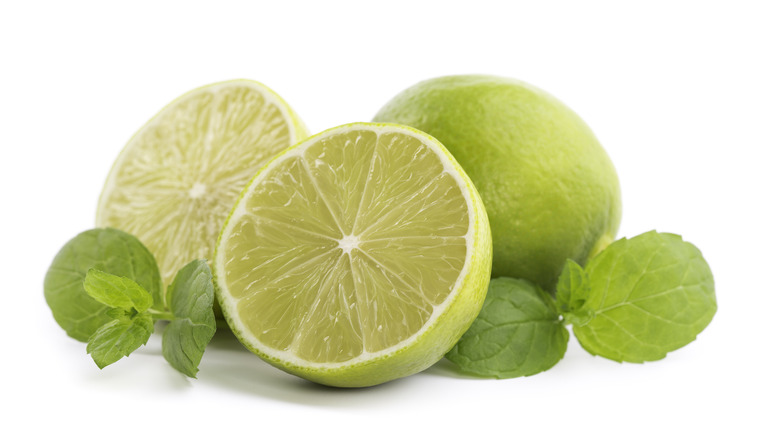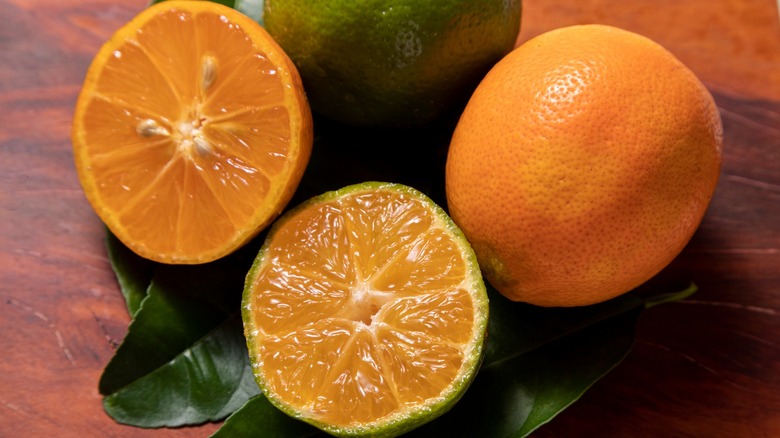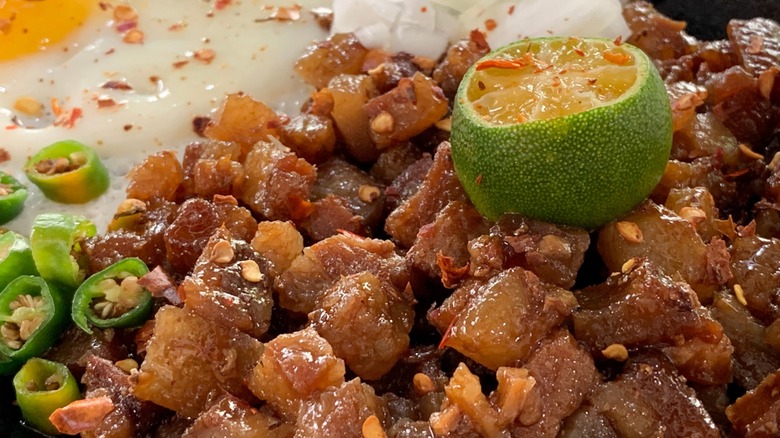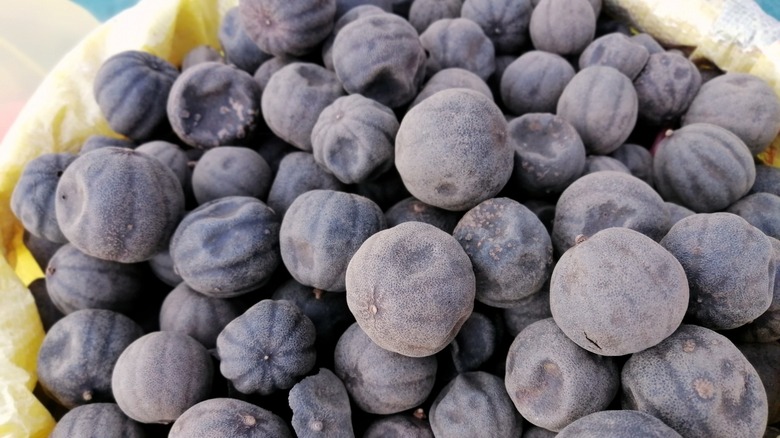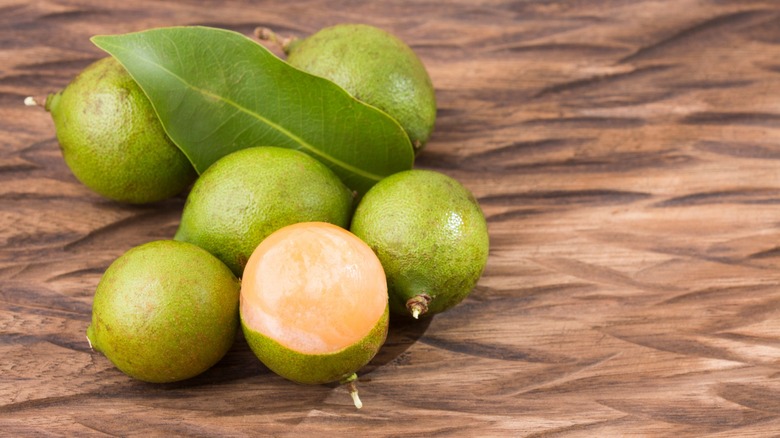11 Types Of Limes And What Makes Them Unique
Limes are a mildly tart citrus fruit that bring to mind refreshing summer recipes and interesting cuisine. We use them to chase back tequila, top off Pad Thai, or splash over grilled shrimp. But, limes are so much more than that. Big-box grocery stores in the U.S. often only carry one or two types. However, there are over 20 varieties of limes, many of which are suitable for cooking.
Often used as a colorful garnish or a versatile finish for dishes, limes are a healthy food choice. Like other citrus fruits, they are high in vitamins, antioxidants, and many other vitamins and minerals, according to Healthline. They have been linked to several physical benefits but are most famous for supporting a healthy immune system.
Limes are a result of hybridization. So far, research from the National Library of Medicine has only confirmed the origins of Mexican lime varieties, which are a hybrid of citron and C. micrantha, a wild citrus fruit native to the Philippines. The exact origins of most other limes are a mystery, but scientists often can make educated guesses, and it is known that most limes grow in tropical or subtropical areas, with a few exceptions. Here, we'll introduce you to a few of the many varieties of limes and provide some usage and cooking tips for each.
Persian or Tahitian limes
Persian or Tahitian limes are most familiar to Americans, but we just call them "limes." These are most famous for Mexican specialties such as guacamole, margaritas, and refreshing mojitos. This is a lime that likes to party!
Why are they called Persian or Tahitian limes? Botanists first thought that this line was spread throughout Europe via Iran, formerly known as Persia. However, a later school of thought claimed that the fruit originated in Southeast Asia and came to California from Tahiti. They're also called Bearss variety, named for a Tahitian lime grown in a California nursery belonging to J.T. Bearss in 1895. Despite these names, the biggest producer of these limes today is Florida.
Whatever it's called, this fruit is a delicious way to add tang to anything, even a glass of water. Persian limes can be added to fish, poultry, rice, baked goods, cocktails, and sauces, used as a finisher, and so much more. You can even add lime juice to olive oil to dress a salad, especially one with avocado.
Key/Mexican limes
Thanks to the popular summer dessert Key Lime Pie, this is the most recognizable lime with a name in the United States. You can use regular, that is, Persian, limes to create this pie without much change in flavor. However, Key limes do differ from their Persian cousins. They are smaller and have a tough skin with a lighter hue. They also have a stronger flavor that's accented by a floral scent.
While Persian limes are more popular in the U.S., globally, Key limes win out. Originally, Key limes were produced in the Sunshine State's Key West region (from which they derive their original name) until a 1920 hurricane devastated the farms. Today, most of this fruit is sourced from Mexico, hence the more appropriate name of Mexican lime.
To add subtle variety to your dishes, try swapping out this version in any recipes that call for Persian limes. Blend their juices with strawberries, coconuts, buttermilk, avocado, and even chocolate to create a crowd-pleasing dessert!
Makrut limes
The makrut lime is often responsible for the unique flavor of authentic Thai food. The skin of this lime has a distinctive, lumpy appearance, but the leaves of this fruit provide the real sensation of taste. Once plucked, makrut leaves are dried, roasted, and cut into strips often no wider than a hair. These are commonly used to season Thai dishes such as red curry or Tom Yum Soup, and sometimes the leaves are ground and turned into a spice.
The zest of the skin is also used in these dishes, but the makrut fruit and its juice are rarely used because of their off-putting flavor reminiscent of lemongrass. Some people have even compared the fruit to soap! The leaves are more subtle. When substituting other limes for makrut, remember to adjust the recipe to cut down the bitterness. Keeping that in mind, you can use this lime to create marmalade, curds, or cocktails.
Limequats
As the name implies, limequats are a hybrid of Key limes and kumquats that make for a sweet and sour taste combination. This citrus fruit is often grown in Florida, which produces three primary varieties: Eustis, Lakeland, and Tavares, names derived from the regions wherein they are grown.
Kumquats do much better in winter weather, therefore, this hybrid can withstand somewhat colder temperatures than most other limes. However, limequats must be kept at 22 degrees Fahrenheit and above and can only be exposed to short bursts of frost as low as 10 degrees Fahrenheit.
Eustis limequats are the most common variety. You can eat them whole. When you bite into one, the skin provides a sweet flavor that is countered by an explosion of tanginess from the fruit. If eating a limequat whole doesn't appeal to you, there are many other ways to use this fruit. One option is to replace Key limes with limequats for another spin on traditional Key lime pie. Limequats are also well-suited for other desserts and sweet treats such as curds, marmalades, and muffins. You can even substitute them for lemon in your lemon bar recipes.
Finger limes
Finger limes are easily recognizable by their finger-like shape. When you cut them open, tiny, flavor-filled spheres spill out. Their appearance gives this fruit its nickname of "vegan caviar." These pearls give a refreshing burst of sour citrus. Like all citrus fruits, they are high in vitamin C. Finger limes are also high in the antioxidant vitamin E., which may help protect your cells from damage.
These limes primarily grow in the tropical areas of Australia, where they originated. They have long been used as food and medicine in the country's bush and desert regions. Sharon Winsor, a bush food expert and Ngemba Weilwan woman from western NSW, said to SBS Food, "Finger limes were often consumed for hydration purposes, especially if someone had to go on a journey and walk long distances."
How can you use finger limes? One of the best ways is to use the pearls of this fruit to complement or garnish fish recipes like sushi or shrimp, or to create vegan versions of your favorite seafood dishes. You can also add their juice as a base for cocktails and serve to friends who do not like their drinks overly sweet.
Desert limes
The desert lime is yet another variety that is native to Australia. It can thrive in high heat and, like finger limes, this fruit is hardy enough to resist the cold. Another similarity is that this fruit is also grown in the bush area of Australia and has long been used in aboriginal medicine.
Desert lime also has numerous health benefits, according to Australia's Native & Delishful Foods. This fruit has a high potassium-to-sodium ratio, therefore, some people think eating it can help reduce blood pressure. This crop also has other purposes. A quick search of Australian Desert lime shows several skincare products — but, can you eat it?
Like all limes, this is another healthy food for cooking. Since desert lime works well blended into condiments, you can use it to flavor butter for shellfish or create an aioli for chicken, seafood, and other recipes that would benefit from its tangy flavor.
This fruit also goes well with a variety of melons and mangoes. If you struggle to find it in the U.S., you can search online to purchase desert lime powder, which is obtained from freeze-drying the fruit.
Sweet limes
Because sweet limes are slightly yellow, they are often confused with lemons. Experts do not all agree, but some botanists conclude this fruit is a cross between a Mexican lime and either a sweet lemon or a citron. This fruit is cultivated in the Mediterranean and the U.S. but may originate from India.
Because they are less acidic than regular limes, sweet limes can be eaten raw or added to a glass of water. This makes them an excellent choice for baked goods and lime curds. When using sweet limes as a substitute for Persian or Key limes, be sure to adjust the amount of sweetener so that you don't ruin your recipe.
Crafting lime-based drinks and cocktail recipes with this lime instead of traditional options allows you to reduce or eliminate how much sweetener is needed. Because it is sweet, these limes may be better suited to create chutneys than marmalades, but you can do either. They also pair well with many fruits to make sweet salsas and fruit salads. We recommend using it sparingly on savory dishes or adding it to seasoning that is complemented by its mild, honey-like flavor.
Rangpur limes
Rangpur limes, also known as Indian Mandarin limes, are a hybrid of mandarins and lemons and look like smaller oranges. While not technically a lime, they are often categorized as such because of their sour taste. They also contain a lot of seeds, making them more challenging to juice without a machine. Rangpur limes taste floral, musky, and smoky. They are available in the U.S., especially in Florida.
What can you cook with Rangpur limes? Like most citrus fruits, marmalades and curds are popular recipes for these limes. You can also add them to baked goods and sugary treats. For example, you can create another variation of Key lime pie or use them to cut down the sweetness of a dish like crème brûlée. This fruit is ideal for crafting cocktails, especially those made with simple syrup, and it can add sophistication to the traditional gimlet.
The unique, smoky flavor of the Rangpur lime makes it a creative choice for recipes such as hummus, hollandaise sauce, ceviche, and guacamole. Its tangy flavor is commonly used in Indian dishes such as prawn curry. Use it to season pork, beef, and seafood. It also goes well with more intense flavors, including juniper berries, bay leaves, or lavender.
Calamansi limes
Calamansi limes have several names, including Philippine, calamondin, or musk lime, depending on where you live. This fruit is thought to be a mix of kumquats and mandarin oranges — technically not a lime, just like Rangpur limes. Possibly indigenous to the Philippines, calamansi is a perfect addition to every Filipino meal.
Calamansi limes have bright green skin on the outside, and inside, the fruit is orange, which makes it an eye-catching garnish. They are frequently used as a finish for seafood since sour flavor blends well with fish sauce. These limes are great for limeade because the fruit has just a bit of sweetness. You can also add their juice to simple syrup or water for a refreshing drink.
Many different fruits work well with calamansi limes, including melons, mangoes, and avocados. Pair it with seasonings such as chili or ginger. As for dessert, calamansi limes are best for cream-based confections such as panna cotta.
These limes complement savory meat dishes, too, including carne asada, chicken skewers, barbequed pork, and steak.
Loomi/dried limes
There are several varieties of dried limes, also known as loomi, that hail from the Middle Eastern country of Oman. These fruits are popular in both Asian and Middle Eastern cooking. Omani loomi are said to have numerous health benefits thanks to their high mineral and vitamin content.
To make loomi, fresh limes are boiled or soaked in brine then left in the sun to dry. This process essentially ferments the limes, imparting a salty, tart, and sweet flavor.
Loomi have black or brown skins, depending on how long they've been drying, but the fruit is always black. It can be ground into a spice and is often brewed as a tea for its nutritional benefits. This dry powder can also be combined with other seasonings to create flavorful spice blends.
The fruits themselves can be heated and cooked. This will rehydrate the loomi, releasing more flavor and giving a rich dimension to stews and other Persian dishes, including sauces and rice recipes.
Spanish limes/mamoncillo
Spanish limes, also called mamoncillo, are tiny, growing to no more than 2 inches in diameter. This tiny powerhouse of nutrition originally hails from the Caribbean and South America. In Jamaica, popular folklore claims that a pregnant woman will have twins if she finds two seeds in her mamoncillo. Today, these fruits are grown in the tropics of the Pacific and Africa but are also widely available in Florida.
Spanish limes are sweet and tangy when ripe. The flavor has been compared to that of both lychees and traditional limes. The trees are able to withstand inclement weather and can grow as tall as full-sized trees.
Typically, mamoncillos are eaten raw but are often used in drinks. Kenep trempe is a cocktail enjoyed throughout the Caribbean that combines rum and Spanish lime with cinnamon, star anise, sugar, and vanilla bean. That sounds like a perfect indulgence to try on your next Caribbean holiday!

